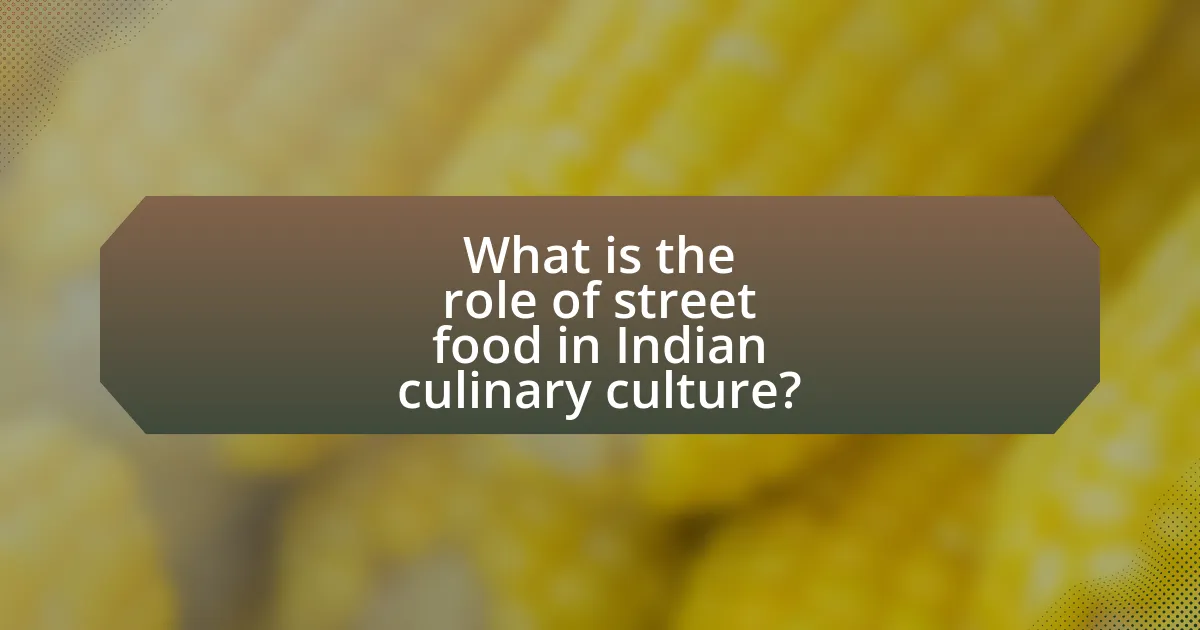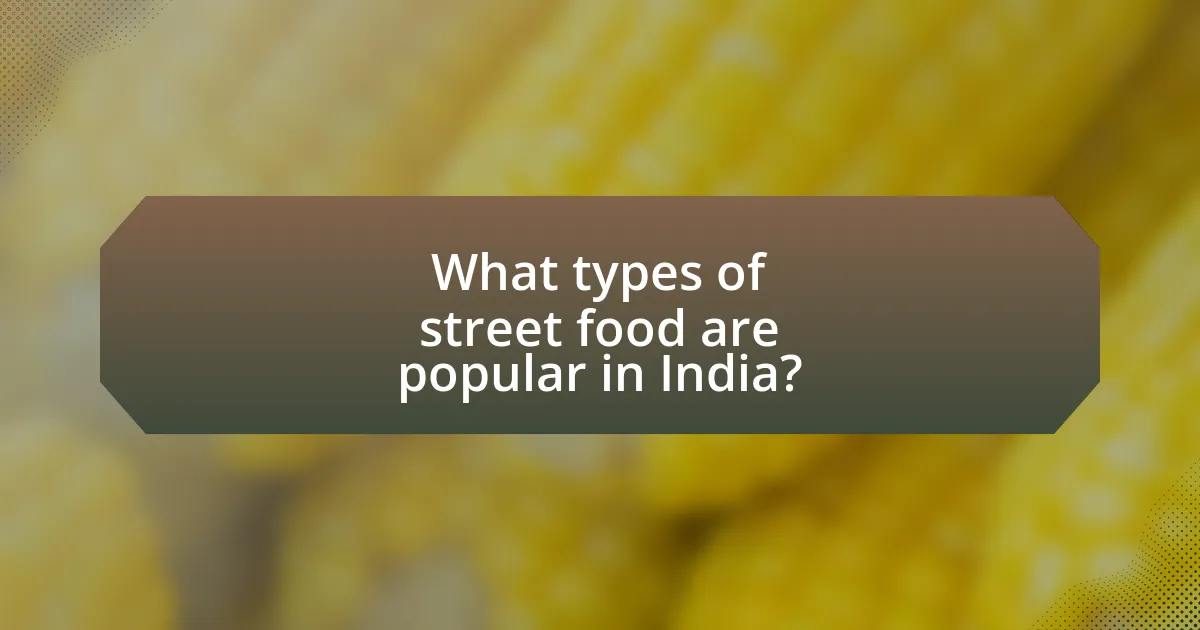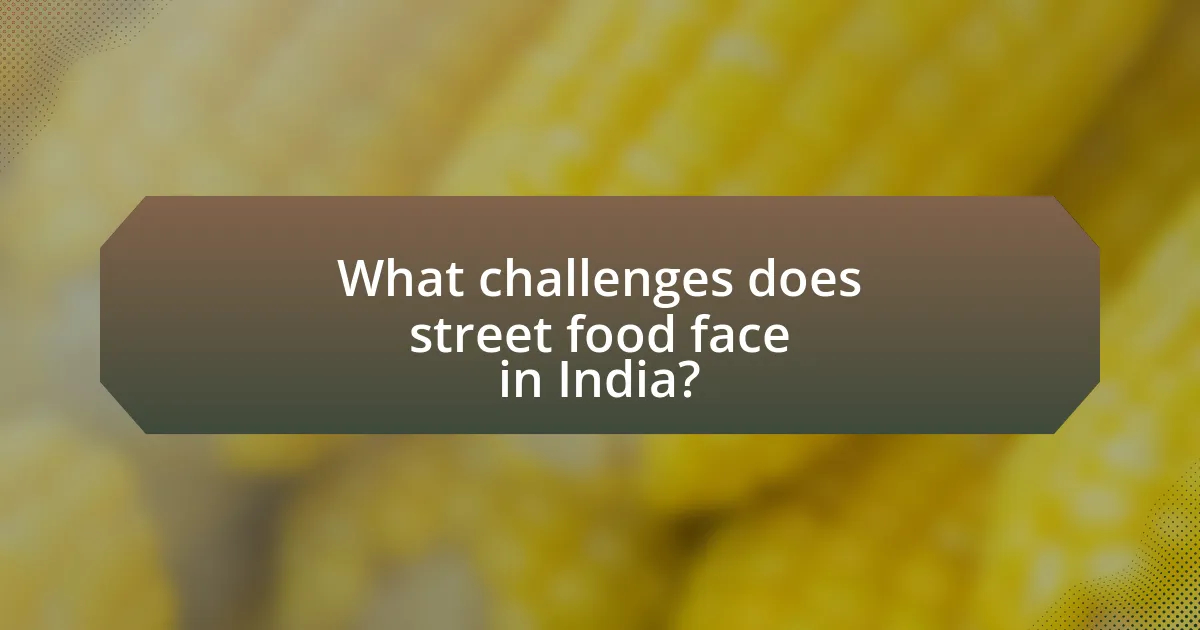Street food is a fundamental aspect of Indian culinary culture, offering diverse and accessible food options that reflect regional flavors and traditions. It serves as a social equalizer, bringing together people from various backgrounds while contributing significantly to the economy by providing livelihoods for millions of vendors. The article explores the evolution of street food in India, its historical influences, regional variations, and its cultural significance, including communal eating practices and social interactions. Additionally, it addresses the economic implications of street food, the challenges vendors face regarding regulations and public perception, and best practices for ensuring food safety. Popular street food items across different regions, along with the preparation methods and cooking techniques employed by vendors, are also discussed, highlighting the rich tapestry of India’s street food landscape.

What is the role of street food in Indian culinary culture?
Street food plays a vital role in Indian culinary culture by serving as an accessible and diverse food option that reflects regional flavors and traditions. It acts as a social equalizer, bringing together people from various backgrounds to enjoy affordable and flavorful meals. Street food vendors often use local ingredients and traditional cooking methods, preserving culinary heritage while also adapting to modern tastes. For instance, popular items like chaat, vada pav, and dosa showcase the rich variety of Indian cuisine and are integral to local identities. The street food scene also contributes significantly to the economy, providing livelihoods for millions of vendors across the country.
How has street food evolved in India over the years?
Street food in India has evolved significantly over the years, transitioning from traditional local snacks to a diverse array of culinary offerings influenced by globalization and urbanization. Historically, street food was primarily regional, featuring local ingredients and recipes, such as vada pav in Mumbai and chaat in Delhi. In recent decades, the rise of urban centers has led to an increase in food variety, with international cuisines like Chinese, Italian, and American being adapted into street food formats.
Moreover, the introduction of food safety regulations and the growing awareness of hygiene have prompted vendors to improve their practices, leading to a more organized street food scene. According to a report by the National Association of Street Vendors of India, the street food sector has seen a growth rate of approximately 10% annually, reflecting its increasing popularity and economic significance. This evolution showcases the dynamic nature of Indian street food, blending tradition with modern influences while catering to a broader audience.
What historical influences have shaped street food in India?
Street food in India has been shaped by various historical influences, including trade routes, colonialism, and regional culinary traditions. The ancient trade routes, such as the Silk Road, facilitated the exchange of spices and cooking techniques, leading to diverse street food offerings across the subcontinent. Colonialism introduced new ingredients and cooking methods, as British, Portuguese, and Mughal influences merged with local cuisines, resulting in unique street food items like pav bhaji and vada pav. Additionally, regional festivals and local agricultural practices have contributed to the seasonal availability of ingredients, further enriching the street food landscape.
How do regional variations impact street food offerings?
Regional variations significantly impact street food offerings by influencing the ingredients, cooking methods, and flavor profiles unique to each area. For instance, in North India, street food often features rich, creamy dishes like chole bhature, while South India is known for lighter, spicier options such as dosa and idli. These differences arise from local agricultural practices, climate, and cultural preferences, which dictate the availability of certain ingredients. Additionally, regional festivals and traditions further shape street food, as seen in the popularity of specific snacks during local celebrations, such as puchka in Kolkata or vada pav in Mumbai. This diversity reflects the broader culinary landscape of India, showcasing how geography and culture intertwine to create distinct street food experiences across the country.
Why is street food significant to Indian society?
Street food is significant to Indian society because it serves as a vital aspect of cultural identity, social interaction, and economic livelihood. It reflects the diverse culinary traditions of India, showcasing regional flavors and ingredients that contribute to the country’s rich gastronomic heritage. Street food vendors often operate in urban areas, providing affordable and accessible meals to millions, thus playing a crucial role in the daily lives of people from various socioeconomic backgrounds. According to a report by the National Association of Street Vendors of India, approximately 10 million street vendors contribute significantly to the economy, highlighting their importance in providing employment and supporting local economies.
What cultural practices are associated with street food consumption?
Cultural practices associated with street food consumption in India include communal eating, social gatherings, and the celebration of local festivals. Communal eating is prevalent as street food vendors often serve large groups, fostering a sense of community. Social gatherings frequently occur around street food stalls, where friends and families come together to enjoy meals, enhancing social bonds. Additionally, during local festivals, specific street foods are prepared and consumed, reflecting regional traditions and culinary heritage. For instance, during Diwali, vendors sell sweets and snacks that are integral to the celebration, showcasing the cultural significance of street food in festive contexts.
How does street food contribute to social interactions in urban areas?
Street food significantly enhances social interactions in urban areas by serving as a communal space where diverse groups gather. The presence of street food vendors creates informal meeting points that encourage socializing among locals and tourists alike. For instance, in cities like Mumbai and Delhi, bustling street food markets attract people from various backgrounds, fostering cultural exchange and community bonding. Research indicates that these interactions often lead to the formation of social networks, as shared dining experiences promote conversations and connections among individuals.
What are the economic implications of street food in India?
The economic implications of street food in India are significant, contributing to both local economies and employment. Street food vendors generate an estimated revenue of around $2 billion annually, providing affordable food options for millions and stimulating local markets. Additionally, the street food sector employs approximately 10 million people, offering livelihoods to many who may lack formal employment opportunities. This informal economy not only supports individual vendors but also enhances the overall economic activity in urban areas, fostering entrepreneurship and innovation in food offerings.
How does street food support local economies and livelihoods?
Street food supports local economies and livelihoods by providing affordable food options, creating jobs, and stimulating local commerce. Street vendors often operate with low overhead costs, allowing them to sell food at lower prices, which attracts a diverse customer base. According to a study by the International Labour Organization, street food vendors contribute significantly to urban employment, with millions of people relying on this sector for their livelihoods. Additionally, street food vendors often source ingredients from local farmers and suppliers, thereby fostering a network of local businesses and enhancing economic resilience within communities. This interconnectedness not only boosts the local economy but also promotes cultural exchange and community engagement.
What role does street food play in tourism and hospitality sectors?
Street food plays a significant role in the tourism and hospitality sectors by enhancing the cultural experience for travelers and contributing to local economies. Tourists often seek authentic culinary experiences, and street food provides a direct connection to local traditions and flavors, making it a popular choice for visitors. According to a study by the World Food Travel Association, 93% of travelers consider food an essential part of their travel experience, with street food being a key component of that culinary exploration. Additionally, street food vendors contribute to job creation and economic growth in urban areas, supporting local communities and attracting tourists who are eager to sample diverse and affordable food options.

What types of street food are popular in India?
Popular types of street food in India include chaat, vada pav, pav bhaji, pani puri, and samosas. Chaat, a savory snack, is characterized by its combination of crispy elements, tangy sauces, and spices, making it a favorite across various regions. Vada pav, often referred to as the Indian burger, consists of a spicy potato filling sandwiched between bread, particularly popular in Mumbai. Pav bhaji, a spiced vegetable mash served with buttered bread, is another staple in urban areas. Pani puri, known for its hollow, crispy puris filled with flavored water, is a beloved snack in many states. Samosas, deep-fried pastries filled with spiced potatoes or meat, are widely consumed as a snack or appetizer. These street foods reflect India’s diverse culinary culture and are integral to its food landscape.
What are the most common street food items across different regions?
The most common street food items across different regions include chaat in North India, vada pav in Maharashtra, dosa in South India, and momos in the Northeast. Chaat, a savory snack made from a mixture of potato, chickpeas, and spices, is popular in cities like Delhi and Mumbai. Vada pav, a spicy potato fritter served in a bun, is a staple in Mumbai. Dosa, a fermented crepe made from rice batter, is widely consumed in South Indian states like Karnataka and Tamil Nadu. Momos, steamed dumplings filled with vegetables or meat, are a favorite in states like Sikkim and Arunachal Pradesh. These items reflect regional flavors and culinary traditions, showcasing the diversity of Indian street food culture.
How do ingredients vary in street food from north to south India?
Ingredients in street food vary significantly from north to south India, primarily due to regional agricultural practices, climate, and cultural influences. In northern India, street food often features wheat-based items like parathas and chole bhature, utilizing ingredients such as paneer, potatoes, and various spices like cumin and coriander. In contrast, southern Indian street food predominantly includes rice-based dishes like idli and dosa, incorporating ingredients such as coconut, curry leaves, and lentils, reflecting the region’s tropical climate and agricultural output. This distinction is supported by the fact that northern states like Punjab and Uttar Pradesh have a higher production of wheat, while southern states like Tamil Nadu and Kerala are known for their rice cultivation.
What unique street food items are found in major Indian cities?
Unique street food items found in major Indian cities include Vada Pav in Mumbai, Pani Puri in Delhi, Dhokla in Ahmedabad, and Dabeli in Vadodara. Vada Pav, a spicy potato fritter sandwich, is iconic in Mumbai, reflecting the city’s fast-paced lifestyle. Pani Puri, a popular snack in Delhi, consists of hollow puris filled with spicy water and tamarind chutney, showcasing the region’s love for tangy flavors. Dhokla, a steamed savory cake made from fermented rice and chickpea batter, is a staple in Ahmedabad, highlighting the city’s vegetarian culinary traditions. Dabeli, a spiced potato mixture served in a bun, is a beloved street food in Vadodara, illustrating the influence of Gujarati cuisine. Each of these items represents the diverse culinary culture and local ingredients of their respective cities.
How do street food vendors prepare and serve their dishes?
Street food vendors prepare and serve their dishes by utilizing portable cooking equipment and fresh ingredients to create quick, flavorful meals. Vendors often set up stalls or carts in busy areas, where they cook items like samosas, dosas, and chaat on-site, ensuring freshness and immediate service. They typically use traditional cooking methods, such as frying or grilling, which are integral to Indian culinary practices. The preparation involves marinating ingredients, mixing spices, and assembling dishes in front of customers, enhancing the dining experience. This method not only showcases the vendor’s skills but also allows for customization based on customer preferences, which is a hallmark of Indian street food culture.
What cooking techniques are commonly used in street food preparation?
Common cooking techniques used in street food preparation include frying, grilling, steaming, and roasting. Frying is prevalent for items like samosas and pakoras, where food is submerged in hot oil to achieve a crispy texture. Grilling is often employed for kebabs and tandoori dishes, utilizing direct heat to enhance flavor. Steaming is used for dishes like idlis and momos, preserving moisture and nutrients. Roasting is applied to snacks like peanuts and corn, enhancing their flavor through dry heat. These techniques reflect the diverse culinary practices found in Indian street food culture, emphasizing quick preparation and bold flavors.
How do vendors ensure food safety and hygiene standards?
Vendors ensure food safety and hygiene standards by implementing strict sanitation practices, regular training, and adherence to local health regulations. They maintain cleanliness in food preparation areas, use safe water for cooking, and ensure proper food storage temperatures to prevent contamination. Additionally, many vendors undergo training programs that educate them on food safety protocols, such as the Food Safety and Standards Authority of India guidelines, which emphasize the importance of hygiene in food handling. Regular inspections by health authorities further reinforce compliance with these standards, ensuring that vendors consistently meet safety requirements.

What challenges does street food face in India?
Street food in India faces significant challenges, including health and safety regulations, lack of infrastructure, and social stigma. Health and safety regulations are often poorly enforced, leading to foodborne illnesses; a study by the National Institute of Nutrition found that 40% of street food samples were contaminated. Additionally, inadequate infrastructure, such as insufficient waste disposal and lack of clean water, hampers food safety and hygiene. Social stigma also affects street vendors, as they are often viewed as unprofessional or unhygienic, which can deter potential customers. These challenges collectively impact the viability and perception of street food in India.
What regulatory issues impact street food vendors?
Regulatory issues impacting street food vendors include health and safety regulations, licensing requirements, and zoning laws. Health and safety regulations mandate that vendors adhere to food safety standards to prevent foodborne illnesses, which can lead to inspections and potential fines. Licensing requirements often necessitate vendors to obtain permits from local authorities, which can vary significantly by region, creating barriers to entry. Zoning laws may restrict where vendors can operate, limiting their access to high-traffic areas. These regulations are essential for maintaining public health and order but can also pose challenges for vendors seeking to establish their businesses.
How do local laws affect the operation of street food stalls?
Local laws significantly impact the operation of street food stalls by regulating licensing, health standards, and location restrictions. These regulations ensure that street food vendors comply with safety and hygiene requirements, which can vary widely across different municipalities in India. For instance, the Food Safety and Standards Authority of India mandates that food vendors obtain licenses and adhere to specific health codes to protect public health. Additionally, local zoning laws may restrict where street food stalls can operate, often limiting them to designated areas to manage traffic and crowd control. Such legal frameworks are essential for maintaining order and safety in urban environments, directly influencing the viability and success of street food businesses.
What challenges do vendors face regarding permits and licenses?
Vendors face significant challenges regarding permits and licenses, primarily due to complex regulatory frameworks and bureaucratic inefficiencies. In India, street food vendors often struggle to navigate the myriad of local, state, and national regulations that govern food safety, hygiene, and business operations. For instance, the Food Safety and Standards Authority of India (FSSAI) mandates that food vendors obtain a license to ensure compliance with health standards, yet many vendors lack awareness of these requirements or the resources to obtain the necessary documentation. Additionally, the process can be time-consuming and costly, deterring vendors from pursuing legal permits. A study by the National Association of Street Vendors of India (NASVI) highlights that over 80% of street vendors operate without proper licenses, primarily due to these barriers, which can lead to harassment by authorities and loss of livelihood.
How does public perception influence street food culture?
Public perception significantly influences street food culture by shaping consumer preferences and acceptance of street food vendors. Positive public perception can lead to increased patronage, as seen in cities like Mumbai, where street food is celebrated for its diversity and flavor, contributing to its popularity. Conversely, negative perceptions regarding hygiene or safety can deter consumers, impacting the livelihoods of street vendors. For instance, a survey conducted by the Food Safety and Standards Authority of India indicated that concerns about food safety directly affect the frequency of street food consumption among urban populations. Thus, public perception acts as a critical determinant in the sustainability and evolution of street food culture.
What health concerns are associated with street food consumption?
Street food consumption is associated with several health concerns, primarily due to issues related to food safety and hygiene. Common health risks include foodborne illnesses caused by pathogens such as Salmonella, E. coli, and Vibrio, which can result from improper food handling, inadequate cooking, and contaminated water. According to a study published in the Journal of Food Protection, street food vendors often lack access to proper sanitation facilities, increasing the likelihood of contamination. Additionally, the use of low-quality ingredients and the potential for cross-contamination further exacerbate these health risks.
How can street food vendors improve their image and attract customers?
Street food vendors can improve their image and attract customers by ensuring high standards of hygiene and food quality. Implementing strict cleanliness protocols can significantly enhance customer trust, as studies show that 70% of consumers prioritize hygiene when choosing food vendors. Additionally, engaging with customers through social media and showcasing unique offerings can create a strong brand presence. For instance, vendors who actively share their culinary stories and menu innovations on platforms like Instagram often see increased foot traffic, as visual appeal plays a crucial role in attracting customers.
What are some best practices for enjoying street food safely?
To enjoy street food safely, prioritize hygiene by selecting vendors who maintain clean cooking areas and use fresh ingredients. Observing the vendor’s practices, such as wearing gloves and using sanitized utensils, can indicate a commitment to food safety. Additionally, consuming food that is cooked thoroughly and served hot reduces the risk of foodborne illnesses, as pathogens thrive in improperly handled food. According to the World Health Organization, proper food handling can prevent up to 70% of foodborne diseases. Therefore, choosing busy stalls with a high turnover of food can also suggest freshness and popularity, further ensuring safety.
How can consumers identify safe and hygienic street food options?
Consumers can identify safe and hygienic street food options by observing the cleanliness of the vendor and their cart, as well as the food preparation practices. Vendors who maintain a clean work area, use gloves, and have proper food storage demonstrate a commitment to hygiene. Additionally, consumers should look for high customer turnover, as this often indicates fresh food and a good reputation. Research shows that street food vendors who follow local health regulations and display health certifications are more likely to provide safe food. For instance, a study published in the Journal of Food Protection found that vendors adhering to hygiene standards significantly reduced the risk of foodborne illnesses.
What tips can enhance the street food experience while ensuring safety?
To enhance the street food experience while ensuring safety, consumers should prioritize cleanliness, choose busy vendors, and verify food preparation methods. Cleanliness is crucial; vendors who maintain clean cooking areas and utensils are more likely to serve safe food. A busy vendor often indicates popularity and higher turnover, which typically means fresher ingredients. Additionally, observing food preparation methods can provide insight into hygiene practices; for instance, vendors who cook food in front of customers often demonstrate better safety standards. These practices are supported by food safety guidelines from organizations like the World Health Organization, which emphasize the importance of hygiene in food handling to prevent foodborne illnesses.
